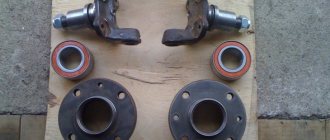Need to know
You can add a heater to the car’s heating system yourself; to do this, you need to buy an additional heating element. Or you can try and make it yourself; for these purposes you will need a second radiator and a housing for a new heating element, which can also be made at home.
Where to put
- In the distance between the front seats where the tunnel is located.
- Under the front seat.
Suitable Models
- Technomaster-8110.0500.10 and 8110.0700.10 (Tolyatti). Its price varies within 3000 rubles.
- Helios, Xeros and Zenith (Eberspächer) - are more expensive, from 3500 rubles.
How to install
The additional heating element is mounted under the front passenger seat.
- Depressurize the engine cooling system.
- Connect the durite hoses of the new heater into the section of the cooling system, so that they do not touch the exhaust pipe of the muffler and the steering elements.
- Make 2 holes of 19 mm each for the pipes in the engine shield.
- Place the heater pipes into the interior under the floor covering.
- Lead the pipes out from under the floor covering near the frame near the passenger seat.
- Secure the pipes using clamps to the additional stove.
- Fill the expansion tank with 2 liters of coolant.
- Check the systems for airiness and remove it if necessary.
- In addition, you can put a special button for an additional stove on the dashboard.
Negative aspects of installing an additional stove in the cabin
- An increase in the heat capacity of the cooling system entails slow heating of the coolant.
- The characteristic noise of the stove in the cabin will be added, since now there will be two of them working.
- The air flow from the stove will raise dust from the interior.
- In the warm season, hot hoses under the floor covering will additionally heat the interior of the car, but there is a way out of this situation - install a tap in the engine compartment when making changes to the cooling system.
- If you do not install another heater regulator and heat dissipation to the side, then there will be no uniform heating, but only one part of the interior will become very hot.
Installing a second heater radiator on a VAZ-2109 will be advisable only in areas with very low temperatures in winter, where the basic heater, despite its proper operation, does not cope with the task and the car does not warm up properly.
Why did the stove stop working on the VAZ 2109, 21099, 2114?
In harsh Russian winters, the stove saves the driver. But often in the most severe frosts it fails. What happened? Why doesn’t the stove work on the VAZ 2109, 21099, 2114? What to do? The age-old question.
Most likely, the stove failed due to a breakdown in the thermostat, which is why the antifreeze is not circulated along the usual route, large and small circles, but only in a large circle. To get the stove working properly, you will have to replace the thermostat, because repairing this part is very problematic and expensive.
The second, most common cause of failure is an air lock. This happens because, after active driving, while the engine is cooling, air accumulates in the radiator, which, under the influence of heat and steam, turns into a thermostat. And, if you start the engine a few hours after such transformations, this accumulated air is pumped into the radiator and, as a consequence of all this, an air lock occurs. You can solve the problem in the following way: you need to remove the pipe and slowly add antifreeze to the stove to the maximum level.
Another cause of stove failure may be the faucet. It is easy to determine the malfunction: if the faucet cannot be unscrewed to the limit, then the whole essence of the problem lies precisely in it. The problem is solved this way: we lift the crane cable, tightening it with pliers. If even pliers and your efforts are not able to move the faucet from its place, it means that oxidation has occurred in it. Then there is no point in repairing the part and you will have to replace it with a new one.
If the radiator is clogged, this can also lead to a breakdown. To diagnose, you just need to pull out the radiator and clean it thoroughly, using a vacuum cleaner. If after such a general cleaning the stove still does not work, then we are looking for the reason further.
It could also be a non-working pump, which affects the pressure in the car. This problem is diagnosed by the fact that the stove starts working at high speed, while idling immediately renders it inoperable. Replacing the pump will solve this issue. But here you need to be extremely careful: recently there have been a lot of fake parts that are not enough for a month. Therefore, purchase components only from a trusted seller, if possible, requiring a quality certificate.
And the last reason for a non-working stove on VAZ 2109, 21099, 2114 may be a decrease in the level of antifreeze. Just add liquid to the desired level, and the stove will again give you its life-giving warmth.
Installing an additional pump
The main negative quality of the basic heating element of the VAZ-2109 is its low efficiency at idle speed. This problem can be solved by installing an additional pump (additional pump) in the cooling system.
Purpose
By installing an additional pump 09, you can increase the efficiency of the stove at idle speed. The base heater blows warm air at idle, and hot air only when driving. This means that fluid circulation in the engine cooling system is poor. Installing an additional pump makes the coolant move much faster, including at idle, therefore, during a stop, hot air will blow from the stove, and not warm as before.
Which additional pump is better to choose?
The most common and proven options are additional pumps from GAZelle or Bosch. These elements do not have any problems with leakage.
Installation of an additional pump from a GAZelle on a VAZ-2109
- Pump for GAZelle
- Relay. You can take a relay with normally open contacts 2105, 2108 - starter or ignition relay and bridge contacts 30 and 86.
- Reinforced hose.
- Cooling.
- Several clamps.
Progress
- Wait for the antifreeze to cool completely and drain it.
- Unscrew the 4 top screws on the pump, where the impeller is located, and coat the rubber gasket with sealant.
- Secure the pump to the studs near the battery.
- Disconnect the coolant wire hose to the heater from the outlet pipe of the cylinder head and connect it to the horizontal pipe of the pump.
- Connect the hose of the connected S-shaped hoses (located in the cabin between the tap and the radiator) to the vertical branch pipe.
- Connect the second end to the head of the block, in the previously removed place of the base one.
- Pull all the clamps and do not forget to tighten the drain plug in the block.
- Fill the coolant to the maximum and check for leaks.
- If necessary, tighten the clamps.
- After running the engine for half an hour, bring the antifreeze level to normal.
So, let's start refining the stove
From the very beginning you need to deal with the cable that opens the stove tap. Typically, it is quite long and does not open the faucet all the way, so the stove does not heat at full capacity. To eliminate this problem, simply cut the cable either from the side of the regulator or from the side of the faucet itself.
Heater valve cable
Try checking the fan operation. It is located in the middle of the bath under the hood, and is covered from water by glass and a casing. Manufacturers cover the air intake hole with paper for some reason. This distorts the air flow and damages the fan itself, so it is better to remove them immediately.
Next, check how strong the air flow is on the VAZ 2109. A fairly common problem is that the bearings that spin the fan itself fail. If in doubt, it is better to replace it immediately. This is quite simple to do, and the bearing will cost you only 500 rubles.
The problem could also be in the fan itself. When replacing a fan with a 2109, it is better to choose only an original unit with high performance. Often, such a fan not only produces a strong air flow and consumes significantly less energy.
- We independently change the heating valve on a VAZ 2107
fan replacement
You can change the fan following this diagram:
- Open the casing that covers the fan;
- Carefully unscrew the bolts that secure the fan;
- Then you need to disconnect one positive connector under the front panel on the driver's side and unscrew the ground on the wires that go to the fan;
- The fan needs to be turned several times so that it moves to the right side of the bath, where it can be easily reached.
Next, rinse and vacuum the stove, try to wipe it as carefully as possible. We make the connection in the reverse order. At the end, carefully seal everything with sealant so that no dust or moisture gets inside.
Often following such a scheme is enough to significantly improve the operation of the stove. But if you still want to achieve an even better result, then you can try several more options for tuning the heating system. Another way to modify the stove is to shorten the cable that turns on the stove lever. Often it is quite long and does not turn on the heating at full power. Just shorten it a little, and there is a possibility that the car will become warmer.
You can also install another heater. It can take air either from a stationary stove or have a separate fan of its own. But such tuning is not always effective.
You can also install additional electric heaters, and their number is unlimited. This should be done according to the diagram. But do not forget that they consume quite a lot of electricity. Although, on the other hand, they can be powered from a separate generator, which is located in the trunk.
As a tuning option, you can try sealing the air valves. The scheme is as follows: you need to thoroughly seal the places where the valve is pressed with good quality foam rubber, soft rubber or a springy seal for any purpose.
We insulate all joints and channels
Modification of the VAZ 2109 thermostat and connection diagram. In order to tune the thermostat, you just need to replace it from 5-hole to 6-hole. The usual size of the bypass channel on a 6-hole thermostat is 11 mm, and on a 5-hole thermostat it is 16 mm. But regardless of which thermostat you have installed, the coolant flow can be easily adjusted. After such tuning, your stove will work much better even at idle speed.
- Removing the valve of the VAZ 2109 stove
Using an aluminum pad, you can independently adjust the bypass diameter within the range of 4 to 6 mm. Using this scheme, you will slightly increase the warm-up time of your VAZ 2109, but the interior will become much warmer than before.
From all of the above, we can conclude that from an ordinary standard stove, with the help of tuning, you can make a fairly powerful heating device that will prevent you and your fellow travelers from freezing.
Do-it-yourself modification of the VAZ 2109 and 2110 stove. There is never enough warmth
If it’s cold inside your car, then you need to modify the VAZ 2109 and 2110 stove yourself.
Such problems usually appear after several years of using the car. Traveling during the cold season becomes problematic and dangerous. Cold air slows down the driver's reaction, and fogged up windows can cause an emergency while driving.
The situation is not pleasant, but we will have to get out of this situation. You will have to find a way out of this situation yourself, since the service refuses such work.
Thermal insulation equipment for foreign cars
Budget foreign cars are popular in Russia, they differ only in better sealing and good stoves. In fact, there is no insulation as such in foreign-made cars.
It is imperative to insulate the interior of foreign cars in our cold weather. If the thermal insulation of the engine can be solved with the help of a car blanket, then the body needs to be worked on. The best insulation material is penofol with its adhesive base and foil.
We remove the decorative door trim, cut out the insulation to the required size, leave holes so as not to interfere with the moving parts inside the door, and glue the foil part outward. Everything is simpler with the trunk; by the way, there are even places for fastening insulation. Usually this treatment is sufficient.
If your region has a more severe climate, you can cover the floor with insulation and cover the ceiling of the cabin with it.
Foreign cars can be equipped with thermal protection made of vibroplast - this material not only dampens vibration, but is also a good insulator in itself. We lay them on the floor, ceiling, all doors and trunk.
To keep the engine warm, we use a car blanket, although some manufacturers offer a plastic plate to cover the radiator, but this is clearly not enough.
In conclusion, it must be said that the more carefully and thoroughly you treat the interior of your car, the more comfortable and safe you will feel on the road.
Recent Entries
BMW 530e Hybrid revised for 2021
The BMW 530e PHEV has been updated with a new battery, improved efficiency, lower emissions and increased electric power range. The hybrid BMW 530e was
Watch a plane crash land on a public road, caught on police dash cam
Starman Adventures Is a Big Hit Among Teslas - SpaceX Fans
New deal offers drivers a free car - life-saving brakes for drivers up to £1,600
Categories
Test Drive
Ferrari Portofino 2019 review
Ferrari Portofino. this is a super stallion that you will ride every day Maximums Spectacular gearbox with excellent shift mechanics
Who said such a blizzard that with a standard VAZ stove it’s warm in the cabin in winter? In our basins there is no way to do without a collective farm, I have a VAZ 2109 in cold weather of -25 or more, slightly warm air blows from the stove and my knees are already freezing, despite the fact that there are no cracks in the casing and the radiator is covered with oilcloth. This is true in all Russian cars. Thank you for the idea. Fortunately, you can experiment in basins; I’ll do the same for myself, but instead of a funnel, I’ll cut a square canister in half. It will probably be even better if you make the option “air from the cabin”, run this hose into the cabin. Farting of course, but warm
Original sensor included. fan on 99/94 - this is for those who don’t know.
Set the thermostat “Granta 2190” to 92 degrees, the sensor is on. fan at 92/85 (so that it doesn’t boil in the summer), cover the radiator with insulation and you will be warm. How to install a thermostat, look in YouTube. I set it for myself and it became much warmer.
Why is it cold in the cabin?
There can be many reasons for this, and they are the same for almost all cars. Sometimes there may be no warmth in the cabin due to the simple carelessness of the car owners. An insufficient level of coolant in the system can ensure the operating temperature of a running engine, but will not provide warmth and comfort in the cabin. Therefore, do not be lazy to occasionally check the coolant level and add antifreeze on time.
Pay attention to the word “on time”; if the moment is missed, an air lock may occur, which will also create problems with heating the interior of your car. We can talk for a long time about why it’s cold in the cabin, but the purpose of the article is different, so next we’ll talk about improving the heating system.
About the modification of the VAZ 2109 stove
Most often, owners of this model pay attention to the fact that there is an uneven distribution of warm air throughout the car. The owners solve this problem on their own. To do this, you need to prepare the following materials:
- Material for compaction, isoline, bitoplast, polystyrene foam or something similar;
- Silicone or acrylic based sealant;
- Next, you need to remove the instrument panel, steering wheel and steering column switches, and the plastic trim on the steering column. After this, you can remove the heater;
- Now it’s time for the heater radiator hoses and the heater valve cable. Then you can remove the heater and radiator into the car interior;
- You need to install swirlers in the stove radiator, which help improve heat transfer. They are spirals made of aluminum or copper sheets that are inserted into the radiator tubes;
- Check the heater body for cracks and inconsistencies in the body panels. If they are present, they are eliminated and additionally glued, where possible, with insulation;
- Achieve such a position of the radiator and the housing so that there are completely no gaps between them;
- Now you can begin to adjust the stroke of the dampers and the tap; this is done by selecting the position of the braid of the drive cables.
After this modification, you can put everything back. Fill in antifreeze, remove the air lock, and you can check the result of your work in action.
So, let's start refining the stove
From the very beginning you need to deal with the cable that opens the stove tap. Typically, it is quite long and does not open the faucet all the way, so the stove does not heat at full capacity. To eliminate this problem, simply cut the cable either from the side of the regulator or from the side of the faucet itself.
Heater valve cable
Try checking the fan operation. It is located in the middle of the bath under the hood, and is covered from water by glass and a casing. Manufacturers cover the air intake hole with paper for some reason. This distorts the air flow and damages the fan itself, so it is better to remove them immediately.
Next, check how strong the air flow is on the VAZ 2109. A fairly common problem is that the bearings that spin the fan itself fail. If in doubt, it is better to replace it immediately. This is quite simple to do, and the bearing will cost you only 500 rubles.
The problem could also be in the fan itself. When replacing a fan with a 2109, it is better to choose only an original unit with high performance. Often, such a fan not only produces a strong air flow and consumes significantly less energy.
You can change the fan following this diagram:
- Open the casing that covers the fan;
- Carefully unscrew the bolts that secure the fan;
- Then you need to disconnect one positive connector under the front panel on the driver's side and unscrew the ground on the wires that go to the fan;
- The fan needs to be turned several times so that it moves to the right side of the bath, where it can be easily reached.
Next, rinse and vacuum the stove, try to wipe it as carefully as possible. We make the connection in the reverse order. At the end, carefully seal everything with sealant so that no dust or moisture gets inside.
Often following such a scheme is enough to significantly improve the operation of the stove. But if you still want to achieve an even better result, then you can try several more options for tuning the heating system. Another way to modify the stove is to shorten the cable that turns on the stove lever. Often it is quite long and does not turn on the heating at full power. Just shorten it a little, and there is a possibility that the car will become warmer.
You can also install another heater. It can take air either from a stationary stove or have a separate fan of its own. But such tuning is not always effective.
You can also install additional electric heaters, and their number is unlimited. This should be done according to the diagram. But do not forget that they consume quite a lot of electricity. Although, on the other hand, they can be powered from a separate generator, which is located in the trunk.
As a tuning option, you can try sealing the air valves. The scheme is as follows: you need to thoroughly seal the places where the valve is pressed with good quality foam rubber, soft rubber or a springy seal for any purpose.
We insulate all joints and channels
Modification of the VAZ 2109 thermostat and connection diagram. In order to tune the thermostat, you just need to replace it from 5-hole to 6-hole. The usual size of the bypass channel on a 6-hole thermostat is 11 mm, and on a 5-hole thermostat it is 16 mm. But regardless of which thermostat you have installed, the coolant flow can be easily adjusted. After such tuning, your stove will work much better even at idle speed.
Using an aluminum pad, you can independently adjust the bypass diameter within the range of 4 to 6 mm. Using this scheme, you will slightly increase the warm-up time of your VAZ 2109, but the interior will become much warmer than before.
From all of the above, we can conclude that from an ordinary standard stove, with the help of tuning, you can make a fairly powerful heating device that will prevent you and your fellow travelers from freezing.
The heating system for the interior of cars of the “ninth family” with a high panel is known for its design imperfections. Despite the fact that she is entrusted with highly specialized functions, she often does not cope with them in the best way. The most common malfunction of the heater on this car is the uneven distribution of warm air through the air ducts. As a result, cold air blows from the side deflectors and onto the windshield, while all the heat is supplied only to the lower pipes. Fortunately, to eliminate this malfunction, there is no need to contact service station specialists - this requires adjustment of the VAZ-2109 heater dampers, which any car enthusiast can handle on his own.
What can be done with the VAZ 2110 stove?
If the stove in this model does not work satisfactorily, you can redo it yourself. Before starting improvement work, you need to make sure that the heater is in good working order and only then begin to modernize it. As a rule, most problems with interior heating occur due to improper distribution of the flow of warm air and its loss through existing cracks.
Many owners dismantle the panel and seal all existing cracks with foam. After this, they begin to refine the airflow dampers. They do not always make it possible to direct warm air to blow on the side windows. In such cases, this is usually done. The edges of the damper are cut out with a regular metal saw, but the air flow on the windshield cannot be touched.
Another reason for insufficient heating of the interior of this model may be insufficient airflow. You can also modify it yourself. You need to find several anthers and a grille, which should be glued to the anther with any glue and set it in place. This modification is advisable for the passenger seat; if installed for the driver, it will heat up the right leg.
Cars of this model produced after 2003 already have a slightly improved heating system, but they sometimes have problems. Modifying the VAZ 2109 and 2110 stove with your own hands allows you to get rid of such problems. In most cases, this does not require any special materials or conditions.
Tuning VAZ 2109
The cold weather has arrived, and most owners of the VAZ 2109 are once again faced with a problem: from the nozzles of the heater pipes at the operating temperature of the coolant (about 90 degrees), barely warm, and often completely cold air is blowing into the cabin; in short, the heater does not heat well. In this state of affairs, in severe frost, even frosty side windows in the cabin “do not come off.”
The simplest solution to this problem is as follows. It is necessary to tighten the heater damper control cable. To do this, you can make one or two turns of this cable on the damper control lever. This lever is located on the body of the VAZ 2109 stove, next to the gas pedal (see photo).
Location of the VAZ 2109 heater damper lever
All the joints of the air ducts and the edges of the stove damper are covered with foam rubber, which is difficult to fully compress using the damper control lever. This leaves a gap of several millimeters. In this case, the damper directing the flow of air either from the street directly or through the heater radiator does not close completely. It closes “up”, while air flows into the front nozzles through the heater radiator, and into the top and side nozzles from the street, through those same millimeters. When the heater fan is running, and the car is moving, these millimeters are quite enough.
You can even get to this damper lever on the driver's side and try to tighten this lever with your hand while the heater fan is on. In this case, the left ear will be in the area of the air duct nozzle, and you can hear how the sound and temperature of the air leaving the nozzle changes.
Also, the reasons discussed below may be the reason for the ineffective operation of the Samara interior heating system.
Incomplete opening of the heater tap
This problem occurs in most front-wheel drive VAZ cars. You can check this by comparing the temperature of the inlet and outlet pipes of the heater radiator; if it is different, most likely the valve is not fully open. The solution is to tighten the control cable for this valve and adjust the valve control lever to the maximum open position. In this case, it is possible that now the valve will not close completely, but as they say, the heat does not break the bones. But here lies another problem. It is known that this valve in Samar is a weak point, and after a certain number of “open-close” operations, the valve at the location of the axis connecting the control lever and the valve itself inside the valve loses its tightness and begins to leak. Some owners simply set the “heat-cold” lever to a certain position and leave it out of harm’s way. In this case, attempting to move the heater tap valve will most likely cause it to leak. If this happens, you can wrap a strip of fabric soaked in sealant around the leak site and fix it all with “cold welding”; this can also be done in the field if the necessary materials are available.
Replacing the radiator of the VAZ 2109 stove
Have you ever heard of a stove radiator? Well, if you have a car, you’ve definitely heard it. Personally, I learned about the heater radiator only after 2 years of using my VAZ 2109 2001. Almost all this time I noticed that when the heater was on, there was some kind of specific smell in the car, but I didn’t pay attention to it. Summer has come and while drying my car, I noticed that there was some kind of dampness under my rugs. “After winter, water. It will dry out,” I thought, but I was wrong. Then, I noticed that antifreeze began to leave the coolant barrel and that was the last straw of my patience. All this time I was afraid to realize that my heater radiator was leaking. What is replacing the radiator of a VAZ 2109 stove? You will learn about this in this article.
Modification of the heater VAZ 2108 - 2109
With the onset of the cold season, I have already written a mini-series of articles about tuning VAZ heaters. Let's remember: this is the post “small tuning of the VAZ heater”, the post “heater noise VAZ 2101-2107”. Now it’s the Samara family’s turn...
Actually, what is the problem? A very common thing is that the heater of a VAZ 2108 - 2109 heats up, but not very much; at idle speed, generally cold air blows... As the speed increases, the situation improves, but not much... Is this a familiar situation? Let's try to figure it out.
How to choose a really excellent radiator for the VAZ 2109 stove.
When I went to an auto parts store, I found out that there are several types: factory aluminum, non-factory aluminum and copper.
After consulting with friends who have been driving for several years and have encountered such a problem, I learned:
Stages of replacing a VAZ stove radiator
To replace the radiator of the VAZ 2109 stove, you do not need to remove the entire panel, as is written on many instructions; I will tell you how to do this without unnecessary hemorrhoids and with little time. So let's get started:
If you have a VAZ 2109, then you need:
- Drain the antifreeze.
- Remove the panel trim.
- Remove part of the speedometer panel.
- Remove the heater trim (which is located below near the gearshift lever).
- Unscrew the panel mounting screws.
- Pull the panel with the help of an assistant from the left edge.
- Unscrew the clamps that secure the pipes to the faucet (be careful, the remaining antifreeze may leak)
- Unscrew the 3 screws securing the heater radiator cover. (There will be problems with the 3rd screw. Ask an assistant to pull the panel harder)
- OK it's all over Now. All you have to do is take out the old radiator, which just fits into the space between the glove compartment and the magazine shelf, install a new one and assemble everything in reverse order (Be careful not to tear off the wires from the ignition and alarm switch)
Photo that will help you:
And finally, a couple of tips:
- Don't wait until winter, it's better to do it this summer.
- Before installing a new stove radiator, peel it off along the edge with foam rubber, just as the old one was covered.
- After replacing the heater radiator, it is better to go to an overpass and stand so that the front is much higher than the rear of the car and rev it up. This will reduce the likelihood of an air lock in the radiator.
Video, replacing the radiator of the VAZ 2109 stove, which will also help you:
The sequence of installing insulation in a car
First of all, choose the material with which you want to insulate the interior of the car. The following tools will be useful to you to carry out the work:
- sheet cardboard;
- scotch;
- marker;
- sealant;
- knife;
- rubber seals;
- screwdriver;
- scissors.
Beforehand, you need to go to the car wash and do a complete cleaning of the interior. Then, better in the garage, our client can dismantle the seats, remove the door panels and disassemble the dashboard. Our client is left with things that are on the back shelf that need to be removed.
After inspecting the condition of the body, close the remaining holes with sealant for our client. Pay particular attention to the area between the engine compartment and the passenger compartment. Remove the heater radiator and seal it, leaving our client with visible seams. Replace worn out old rubber seals with new ones.
You need to start treating the interior for insulation from the floor of the body. Carefully clean the underbody of the car and treat it with solvent. Prepare patterns from cardboard sheets.
Buy the calculated volume of material in the store, plus a small supply. Using the made cardboard patterns, cut out the penofol to the required size. If you have material without an adhesive layer, then you will also have to purchase Tilit glue to connect the seams of the heat insulator.
We move to the doors, wash them carefully and treat them with solvent, then cut out holes for the handles. We glue the pieces of heat insulation in the same way as on the bottom. Clips are used in places with a pronounced relief; we fasten them inside using furniture staples.
We looked at general tips for insulating the interior of a car without the help of others. In the next section, we will look at the installation of heat insulation for different cars.
The device of the VAZ-21099 stove
There would be no question of any comfort while traveling in a VAZ-21099 car if the interior of this sedan were not equipped with a heating system. Moreover, ensuring a comfortable temperature in the cabin can be considered a secondary task, and the main one is heating the glass (windshield and side front doors) to ensure visibility in conditions of reduced temperatures.
The VAZ-21099 uses a heating system that is classic for all cars, in which the air is heated using an additional radiator of the cooling system installed in the cabin under the dashboard. Thanks to this location, it is possible to provide heating for several zones - airflow onto the windshields and side windows, under the feet and directly into the cabin itself.
To ensure the efficiency of the stove, it is necessary that the flow movement is not spontaneous (due to temperature changes), but forced. And for this purpose, the heating system is additionally equipped with an electric fan.
Heater tuning VAZ 2108 – 2109
My advice to you is, before doing other modifications, try to pay attention to the heater core. Sometimes the radiator is so dirty that there is no question of any coolant passage. Perhaps it has simply outlived its useful life and needs to be replaced. Next, what I would like to pay attention to is the pump (coolant pump). An improved and more productive option is Luzar Turbo and TZA Premium. Luzar Turbo comes with two types of pumps:
- 21114-1307010 (LWP 01084), it is equipped with VAZ 2108 - 2115 cars, with an engine with an 8-valve cylinder head.
- The pump 21124-1307010 (LWP 01124) is equipped with VAZ cars of the tenth family, Kalina, Priors, with a 16-valve head, which were produced before 2008.
After reading a little data from the manufacturer, we can answer the question - why is Luzar Turbo better than a regular pump?
- The manufacturer stated that this pump has increased performance, the value is (on average) 12.5%, while the engine does not lose power. And consequently, the higher the rate of coolant flow through the system, the more stable the engine temperature.
- The average temperature in the engine is also reduced, which has a positive effect on durability.
- Performance improves during the so-called “thermal shock” - a sudden stop in coolant circulation, this is observed when the speed is reduced.
The difference in the design is the impeller, which is made of stainless steel sheet and equipped with a large number of specially shaped blades.
Another important result in favor of Luzar is that in tests conducted in the magazine “Behind the Wheel”, it took first place. The reviews are generally positive, you can try installing it.
As for cracks and leaks, they are eliminated with the help of foam rubber, glue, good tape, and construction silicone. The main places where cold air enters the cabin are shown in the figure:
Design of the VAZ-21099 heater
And then everything is simple: the created flow passes through the radiator honeycombs, where heat exchange occurs, as a result, heat is transferred to the air, which then blows into the required zones through the air ducts.
The design of the VAZ-21099 stove includes several main components:
- stove body made of plastic;
- heating system radiator (connected to the cooling system);
- electric fan;
- air ducts;
- heater control mechanism.
This car used heaters of two modifications (old and new), which were slightly different in design, but their components were completely identical.
Housing, radiator, dampers
Thanks to the housing, the required redirection of heating is ensured, since the movement created by the fan motor is immediately fed into it, rather than being dissipated. The body of the VAZ 2109 stove itself consists of two halves, connected to each other with special brackets. To reduce flow losses, a seal is placed between its halves. Partitions are made inside both halves, which provide the correct direction.
There is also a niche inside this case into which the radiator is installed. Initially, the radiator was made of brass, but now it is almost always made of aluminum. The design of the stove radiator 2109 is identical to the main one (consists of two tanks, tubes through which coolant circulates, and plates that form honeycombs), but is significantly smaller in size.
Video: The stove in the VAZ 2108, 2109, 21099, 2110, 2111, 2112, 2113, 2114, 2115 HEATS poorly
Air is blown through the stove dampers, also installed inside the housing. These elements are movable, and thanks to them it is possible to close some and open other air ducts. There are three of them in total - the main one (heater control), an air duct that redirects between the foot area and the supply to the cabin, and a damper for supplying flow to the windshield.
Additional flaps are installed on the side and central deflectors. It turns out that by default, air from the housing constantly blows onto the deflectors and this is done so that the flow always has an exit. Thanks to the existing dampers, it is possible to provide simultaneous supply of hot air to several zones at once (the interior and the windshield or the windshield and the footwell area).
The main heater damper provides air flow to the radiator or bypasses it. This is all done because the heater also plays the role of a forced ventilation system for the interior. This allows for a supply of cool air in the summer. And to do this, you just need to redirect the movement bypassing the heat exchanger, and the supply of heated coolant to the radiator itself will stop. To disconnect the heat exchanger from the cooling system, a heater tap is used, which is located on the supply pipe in front of the radiator.
Fan
The air flow is created by a squirrel wheel fan driven by an electric motor. These two elements are enclosed in their own separate housing, installed on top of the heater housing. Moreover, it is structurally designed to provide the easiest possible access to the electric motor, since it is considered one of the weakest components of the system.
The design provides three modes of fan operation. This allows you to select optimal air supply conditions (cold or hot).
Control mechanism
Video: Useful tips for cars. Why does the VAZ stove not work?
To control the stove and redirect air movement and open and close the coolant supply valve, a control mechanism located on the center console is used. It consists of a three slider mechanism and a fan operating mode switch.
The lower slider is the main one, since it changes the system mode (heating or ventilation). It controls two elements at once - the main damper and the tap. When this slider is switched to the “ventilation” mode, the tap and damper are simultaneously closed, which ensures air movement bypassing the heat exchanger. And everything is exactly the opposite - when you switch it to the “heating” mode.
Heater diagram
The heater is mounted in the cabin under the dashboard using nuts on bolts that are welded to the air supply box. The air heated in the heater through channels (air ducts) enters the interior of the cabin. The air ducts are located at the bottom of the dashboard and have sealing gaskets.
If you plan to carry out repair and maintenance work, or replace failed components yourself, you definitely need to study the design of the stove and become familiar with the location of the components.
Based on the diagram below, we will introduce you to the design of the VAZ 2109 stove.
| Item number | What is this |
| 1. | Bracket for fixing stove casings |
| 2. | Heater control damper |
| 3. | Left heater casing |
| 4. | Flap rod for heating the foot area |
| 5. | Radiator gasket |
| 6. | Radiator |
| 7. | Gasket sealing stove |
| 8. | Electric stove motor |
| 9. | Heater fan shrouds |
| 10. | Fan impeller |
| 11. | Heating damper |
| 12. | Air duct for heated windshield |
| 13. | Side nozzle duct |
| 14. | Side nozzle |
| 15. | Center nozzle flap |
| 16. | Pusher (blades); |
| 17. | Blade axis |
| 18. | The blade itself |
| 19. | Center nozzle closing lever |
| 20. | Heated windshield damper rod |
| 21. | Lever for changing air flow directions |
| 22. | Air heating control knob |
| 23. | Windshield air handle |
| 24. | Leg air handle |
| 25. | Bracket for control levers |
| 26. | Rod sheath fixation bracket |
| 27. | Stove valve control rod |
| 28. | Stove control damper rod |
| 29. | Heated footwell flap |
| 30. | Air control lever axis |
| 31. | Screw clamp |
| 32. | Stove valve |
| 33. | Heater valve body |
| 34. | Valve lever |
| 35. | Hoses connecting the faucet to the heater radiator |
| 36. | Internal ventilation duct |
| 37. | Heated windows for rear footwells |
| 38. | Stove tap |
| 39. | Window for heating the driver's foot area |
| 40. | B-pillar trim |
| 41. | Inner cavity of the central pillar |
| 42. | Exhaust ventilation duct |
| 43. | B-pillar trim |
| 44. | Hood deflector lining |
| 45. | Rubber valve |
| 46. | Deflector housing |
| 47. | Exhaust ventilation deflector |
| I | Heater |
| II | Stove operation diagrams |
| III | Stove tap |
| IV | Interior exhaust ventilation |
Having become acquainted with the components of the VAZ 2109 stove, let's find out in more detail how everything is arranged and functions here.
Device location
- Replacing the VAZ 2114 stove tap with your own hands - signs of a malfunction, where it is located, choosing a new part
Heaters old and new
Finally, we note that the VAZ-21099 of different years of production used heaters with certain design features that related to the angle of the radiator and the location of the main damper.
In so-called old-style stoves (on cars before 1998), the radiator was installed almost vertically, and the main damper was located under the heat exchanger. There was a partition between the rear wall of the case and the radiator, which formed a channel that provided air supply down the case.
When the damper was open, the air flow moved through the radiator, where it was heated and supplied to the air ducts. In ventilation mode, the main damper closed the heat exchanger, forming, together with the front wall of the housing, another channel through which the flow went directly to the air ducts.
In the new model stoves (on cars produced since 1998), the radiator position angle was significantly smaller than on old heaters, which is believed to provide a larger contact area of the air flow for heat exchange.
The position of the main damper and its shape also changed (it became arched). It began to be located above the radiator. In the closed position (ventilation mode), the damper ensures air movement along the shortest path to the air ducts. In heating mode, it blocked the cold air supply channel to the air ducts and directed the flow down the housing, from where it went to the heat exchanger.
see also
Comments 11
those. The factory version did not provide for complete closing of the damper? Weird
Yes, there is no damper there at all, in the photos there is a damper that cuts off the air in the legs, now it is multifunctional) The factory planned that you would cut off all this with air ducts (which are on the dashboard) only there are crazy gaps and they don’t really cut off anything
got it, what can I say... bastards
Well, it’s all been worked out over the years, maybe it worked in the beginning)
got it, what can I say... bastards
and I hammered the central nozzle, making two small holes (3x2 cm each). As a result, it blows a little in the center and blows like crazy on the sides.
I myself had a 2108 with a high torpedo. It also didn’t heat up properly. The contents of the ash scattered. In the end, like you: 0 - and the most important thing - I changed the heater radiator. Instead of aluminum I installed copper (from Tavria) and taped all the joints with foam rubber. 2-Plugged the air duct under the radio tightly. Since the radio is hot, and to heat the interior ((( 3-I tightly plugged the air duct in the heater for the rear passengers' feet. I was driving alone and warmth for the rear passengers was of secondary importance. 4-The kinematics of the heater control levers is not correct. Either the valve is open and the cold air damper is slightly open , or the damper is closed, but the faucet is not fully open. I couldn’t overcome this illness, so I adjusted it so that the damper closed completely, and the faucet opened forcibly. 5-I cut ventilation windows into the ceiling along the rear seal) there were holes in the body, and in the ceiling For some reason they were removed. I cut them in place. As a result, the air began to blow wherever you directed it. It was hot)))))
There is also a joke in the stove itself, why everyone says that the low panel is hotter, the point is not in the dashboard, but in the stove, the radiator is located there differently and it gives off more heat. On the left is the old one on the right is the new one. I stuck my old one in with a special one.
The heater with NP fits perfectly onto the VP. And with the stove in the VP it becomes much hotter
Yes, I know, that’s why I looked for it and found a new one made in the USSR.
The coolest thing was in the radiator, on one side it said made in the USSR and on the other it was made in Russia, they collected it from leftovers)
Surely, many owners of VAZ “nines” have experienced the imperfection of the design of the heating system of this car. The main problem here is not that the stove does not heat at all. No, warm air is supplied to the cabin, but its distribution is uneven. This problem is most acute for owners of the VAZ-2109 with a “high” panel. In this case, it makes no difference which fuel supply system is a carburetor or an injector. The problem is relevant for the entire model range, and only some kind of tuning of the heating system can solve it.
How to remove the heater radiator yourself and not freeze in your Zhiguli car?
If you have fallen on hard times and it is not possible to contact a car repair shop or service center, or you are convinced that you should take care of your car yourself, and the time has come to replace the heater radiator of your VAZ 2109, do not despair, do not be scared and read this article carefully. First of all, let’s remember where this radiator is located. So, our “hero” is located on the right heater casing (to the right of the heater control panel), direct access to it is blocked by the instrument panel console.
How to get there?
There are two ways to get to the radiator. First
(it can be called classic) is carried out strictly in accordance with the manual for the operation, maintenance and repair of VAZ 2109 vehicles and involves draining the coolant from the engine cooling system and removing the instrument panel.
The second one
belongs to the category of “folk” and does not require such complex manipulations. In this article, consider both methods, but you will decide for yourself which one to use.
The classic method of replacing a VAZ 2109 heater radiator
After this, the old radiator of the VAZ 2109 stove is directly replaced with a new one and all elements are installed in the reverse order. This is exactly how replacements should be made in auto repair shops and service centers. For those who decide to do this work on their own, it is necessary to take into account that the entire process will take from 4 to 6 hours.
"Folk" way
Folk craftsmen - brave and desperate craftsmen - offer a less labor-intensive method. Its essence is that the stove is replaced without draining the coolant and dismantling the dashboard.
In this case, in your VAZ 2109, replacing the heater radiator will be carried out according to the following scheme
:
- Close the heater tap.
- Remove the right front seat (for ease of work).
- Unscrew the two screws securing the panel on the right side, one screw that is located in the glove compartment, and, pulling the panel towards you, place a wooden block. Now you can get to the heater radiator from below on the passenger seat side./li>
- Place rags on the floor of the cabin and prepare containers to collect coolant that spills from the heater radiator and pipes.
- Loosen the screws on the pipe clamps and carefully remove them one by one from the radiator, placing a container into which 200 - 300 g will drain. coolant.
- After unscrewing the three bolts securing the radiator to the heater, pull it down to the right.
- Install the new radiator in reverse order.
Determining the causes of a windshield wiper malfunction on a VAZ car
wipers If suddenly the wipers on your car stop working, this is not a reason to panic. This device is quite simple and, if desired, anyone can independently eliminate the cause of the malfunction by following the further instructions. And so, let's find out why the wipers on your VAZ-2105 do not work.
How to independently replace CV joint boots on a VAZ 2109.
The CV joint boots are a front-wheel drive unit, which is popularly called a “grenade”. The reasons that lead to their damage can be different: aging of the material, hitting an obstacle, as well as careless operation of the car.
Learning to repair Lada Priora: dismantling and installing the main brake cylinder
In the current Lada Priora model, AvtoVAZ engineers were able to eliminate some errors that occurred in the tenth series.
Lada 110: techniques for removing and replacing the radiator Part 1
If the car owner notices an antifreeze leak, then the heater radiator installed on the VAZ 2110 should be replaced.
How to properly and quickly remove the gearbox of a VAZ 2109 - useful tips for beginners
Almost every car owner encounters such a problem as removing a VAZ 2109 gearbox.











